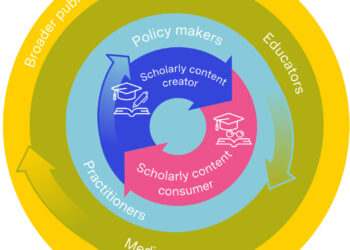
- Image via Wikipedia
A recent piece in the New York Times on ebooks and libraries raises the question of how publishers will come to terms with the possibility that the sale (or lease) of one copy of a book will lead to multiple readers of that copy, undermining the market for that title. While I’m confident that various practical lending schemes will emerge over the next few years, it’s also clear that publishers will be looking for other ways to reach paying customers. A “library bypass” strategy is on everybody’s mind, or will be once ebooks pick up market share.
Library bypass is not yet another evil visited upon libraries by avaricious publishers. In fact, it is very much the opposite. A bypass strategy develops precisely because publishers are listening to libraries. They hear two things: first, libraries are short of funds and cannot purchase all the materials that they would like to; and, second, libraries increasingly are becoming publishing centers themselves, typically of open access material, and are casting a cold eye on yet another offering from a highly profitable publisher. A bypass strategy is a prudent means to find other ways to derive revenue from publications without imposing a further tax on a library’s strained materials budget.
A bypass strategy typically involves the creation of an aggregation, whether by a publisher or a third-party, which is marketed directly to end-users. I say “typically,” but please don’t look for evidence of such implementations under every rock. Most of these “typical” programs are embryonic, put together by new companies seeking a toehold in the publishing marketplace. (Some of these companies are clients of mine, but I will forebear making a plug here—but talk to me offline.) These programs replace or will come to replace other programs, including the attempt (very expensive) to sell single titles of books or serials directly to end-users or some licensing schemes that are priced more for small businesses and libraries rather than for individuals. An effective pricing strategy would make all the digital resources of a research library available to individuals for a flat sum. How much that sum should be will be a matter of intense debate in the coming years. To put this in perspective, our household pays about $1,000 a year for daily home-delivery of the New York Times (and we would—happily–pay more if the paper included no advertisements). There is a market here.
This raises the obvious question: Why aren’t libraries themselves getting into this area? Good question. In some respects, they are. For example, most public libraries allow patrons to access digital collections from home — all you need is a library card. But these services are hardly comprehensive. University libraries typically have programs for members of the broader community, but these entail accessing resources from the library’s physical premises. It’s more likely that an independent researcher (or simply an intellectually curious individual) would like to access materials like St. Jerome, from his study. Our iconic prospective customer can be termed “St. Jerome in pajamas.”
Thus the entrepreneurs are making an attempt. There are many, many obstacles to making such a program work. For one, you have to arrange deals with all the publishers, which, frankly, is as hard a task as any in the world of media and communications. Second, you need a tight set of business rules for revenue-sharing. Third, you need very good information technology to track all this activity. And you need a sophisticated authentication scheme to ensure that a small business is not trying to horn in on the price for an unaffiliated individual. But seemingly insurmountable obstacles are the lifeblood of entrepreneurs.
Speaking as one of those unaffiliated individuals (a so-called independent knowledge worker), I wonder why it is that some companies won’t take my money. I live 100 yards from a campus of the University of California, but cannot get remote access to the UC digital collection at any price. This situation won’t last; the pressure of a knowledge economy, coupled with the incentives of enterprise, will bring the riches of the world of information to my study.
My PayPal account is ready.
Discussion
8 Thoughts on "What is “Library Bypass”?"
Rather than looking for a library by-pass, how about a library pass-through? My library provides hundreds of assorted databases and ebooks for our campus users. Once our students graduate, they are no longer able to access those same resources as alumni unless they physically come back into the library.
Many of them would like to continue to use those materials, but our licenses with the publishers restrict access to currently enrolled students and currently employed faculty/staff. The vast majority of our graduates are not going to pay the high cost of license fees for this information, but they might pay a small fee to get remote access as an alumnus. This is a question that we get on a regular basis and to my knowledge only Proquest has made any provisions at all for alumni to be included in their license.
If the publisher and the library were able to work together, a fee structure could be developed that would allow independent researchers to subscribe through the library, with both publisher and library collecting a piece of the fee. The library would serve as a marketing arm for the publisher and the publisher would see some increased revenue. While there will never be enough who want continued access to generate vast amounts of additional income, something is always better than nothing (especially in these economic times).
So rather than work around the library, publishers should work with the library to expand access to materials that we already have, generating additional income in the process. This allows the library to better serve its community and the publisher to reach customers that they would never reach independently — a definite win-win situation for each side of the information equation.
Dave makes some excellent points about how information is delivered; however, there is another aspect to consider, namely service.
Librarians are expert at helping people find the information they need. In publicly funded institutions, that help is offered to all, not just to specific clients.
The information may be out there, but the librarian can help people to find the most relevant information, not just what shows up on the front screen of Google.
That’s something publishers can’t provide.
![Reblog this post [with Zemanta]](http://img.zemanta.com/reblog_e.png?x-id=78938f32-fe33-4789-be73-cb03e878587b)


